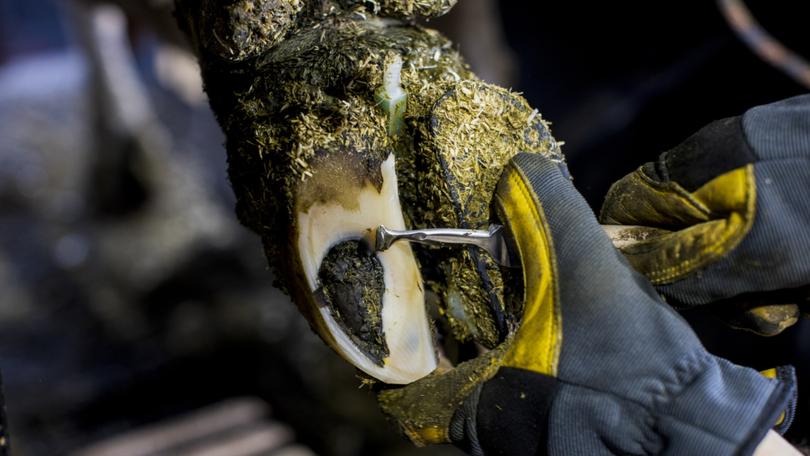THE NEW YORK TIMES: ‘Oddly satisfying’ cow pedicure videos are a hit on TikTok

There are many paths to internet stardom, but there are only a few ways to correctly trim a cow hoof.
Nate Ranallo, a bovine podiatrist in West Salem, Wisconsin, prefers the Kansas method because the trim conforms more organically to a cow’s claw shape. Graeme Parker of Wigtownshire, Scotland, is partial to the Dutch method, which follows a five-step system to keep cattle walking in full stride.
What Ranallo and Parker have in common are legions of fans on social media who may never have set foot on a farm, but find it unexpectedly calming and satisfying to watch them file, sculpt and mend cow hooves while narrating their methods and steps.
Sign up to The Nightly's newsletters.
Get the first look at the digital newspaper, curated daily stories and breaking headlines delivered to your inbox.
By continuing you agree to our Terms and Privacy Policy.Trimming does not hurt a cow — it’s akin to clipping a human toenail. And it is necessary; farmers routinely hire skilled workers to pare back the hooves of their dairy cows, which, unlike wild bovine, don’t roam very far, so the natural wear and tear that keeps hooves from becoming overgrown doesn’t occur.
Ranallo and Parker began posting instructional videos to teach farmers and to advertise their services. But it wasn’t long before the videos found their way into the TikTok and YouTube feeds of casual scrollers, who found themselves mesmerized by the methodical, precise handiwork.
Between them, Ranallo, who posts under the handle Nate the Hoof Guy, and Parker, aka The Hoof GP, have more than 6 million followers across the two platforms.
“I misread where the interest would come from,” said Ranallo, 45, who has been trimming cow hooves since he was in college and posted his first video in 2020.

Many commenters have said they found the videos “therapeutic,” he said. “Even though I presented in an educational format, they were using it as more of an entertainment source.”
Ranallo works on about 10,000 hooves a year on farms within about a half-hour’s drive of his home. He said he has noticed that viewers were drawn to the stomach-churning aspects of trimming, such as the treatment of ailments, some of which are bloody.
The soft tenor of his voice often stands in contrast to the images in his videos, some of which are not for the squeamish, involving the treatment of oozing lesions or the removal of painful detritus.
“No, we do not stud the tires of the cows in Wisconsin,” Ranallo says cheerfully in one video, as he removes caked-on mud from the bottom of a hoof. “She has stepped on a screw.”
The videos make viewers feel as if they, too, might be able to help a cow in need.
“From an evolutionary standpoint, it’s a trait we could learn,” said Craig Richard, a professor of biopharmaceutical sciences at Shenandoah University in Virginia. “If the person’s not threatening you and transforming something, your brain starts to wonder, ‘Could this help me survive? And could I learn this trait from them?’”
But Richard, the host of the podcast “Calm History,” said that watching a transformation that leads to a satisfying result is what can keep viewers staring at their screens.
“What’s happening is our dopamine is lighting up,” Richard said.
The videos, he said, fall under the umbrella of “oddly satisfying,” and translate to relaxation.
But the trade isn’t always so meditative for the trimmers.
At one point in his career, Parker was starting his day between 2 and 4 a.m. He would drive to cattle farms with his tools, slide a cow’s hoof into a chute and begin to file and slice.
“If you had something sore on your foot, the first thing you’d do is get the weight off,” Parker said. “A cow doesn’t — a cow is a prey animal, so if she limps, she thinks she’s going to be food.”
Most trimming is not unlike a manicure or pedicure, but sometimes greater attention is needed.
Parker began posting videos mainly so potential clients would understand what he could do with an angle grinder and a specialized tool called a hoof knife. As more farmers began watching them, he said, “then the public started watching as well, and from all over the world.”
Now, his channel has merchandise and a dedicated fan base that calls itself “The Herd.”
At a conference earlier this year, Parker said that he met several people who had changed careers to take up hoof trimming, citing his videos as inspiration. “That’s changed my outlook on what the videos can achieve and what they do,” he said.
Ranallo, who also has a large fan base, at one point found himself dealing with account impersonators who reposted his content, claiming it as their own. They became so prevalent that Ranallo hired a copyright lawyer. He described the process as “a nightmare,” but said the issues have since been resolved.
Even though Ranallo and Parker have each found success with a general audience, their days still begin and end with helping cattle stand on four legs. Juggling social media videos with their trade can be a challenge, but the two have struck a balance between their internet fame and an honest day’s work.
“You don’t want to make it look like there’s a bunch of limping cows all over the country — it is a very small fraction,” Ranallo said. “But at the same time, as a creator, you’re trying to give the viewers what they want to watch.”
This article originally appeared in The New York Times.
© 2024 The New York Times Company
Originally published on The New York Times
